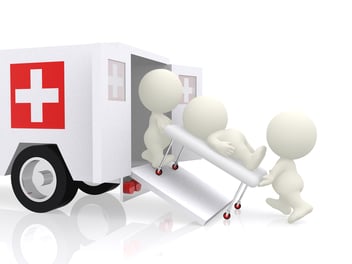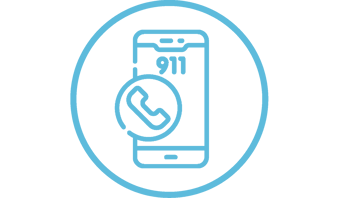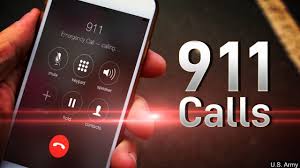E911 Cloud Functionality - Answering Your Questions
Over the past year, cloud calling usage has skyrocketed. Although COVID-19 has been one of the primary motivators, the shift from on-premises to cloud-based systems was already well underway; the pandemic just streamlined the change. Digital transformation initiatives depend highly on communications, and cloud systems deliver innovative features much faster than legacy systems. It used to be considered bleeding-edge to move communications to the cloud, but nowadays, it's the norm and risky not to take advantage of the cloud.
With the many technological advancements and quick acceptance and adoption of cloud technology, there are still apparent E911 questions to confirm with the majority of cloud systems. We will address some of the most common questions regarding E911 and cloud functionality.

What Does Kari's Law and the RAY BAUMS Act Have to Do With E911?
Businesses are now required to adhere to new federal E911 requirements. Congress recently passed both the RAY BAUMS Act and Kari's Law into law after the FCC established its regulations. All companies around the country have a means of achieving three objectives to fully comply with this new legislation, thanks to cloud phone technology.
What are the Current E911 Regulations My Business Must Comply With?
Federal regulations for E911 were enacted over the past couple of years. Kari's Law mandates immediate 911 access rather than using any prefix when dialing 911. Additionally, a specific person within the organization must be informed when an emergency call is made. A phone call, text message, email, or use of an HTTP API are generally used to communicate with the security team, front desk agent, or designated party.
Kari's Law has been active since February 16, 2020. The law states that "if the system is capable of being set to give the notice without an enhancement to the hardware or software of the system," businesses are not explicitly required to update their communications equipment to comply. However, for safety reasons, it is advisable. If an organization can send out notifications through its network, they are required to do so.
For RAY BAUMS Act, the FCC mandates that a "dispatchable location must include the accurate street address of the 911 calling party and any additional information, such suite, apartment, or similar information, that is necessary to identify the caller's location accurately."
What Happens if My Business Doesn't Comply With the Regulations?
The FCC decides on fines and other repercussions for non-compliance in accordance with its enforcement guidelines, policies, and processes. It is vital to remember that the family of Kari Hunt, whose tragic death prompted the passage of Kari's Law, got a $41.5 million compensation for non-compliance. Businesses that don't comply risk a lot by not following these regulations, including the safety of their team members and clients, severe fines or penalties, and an impact on their brand.
Is E911 the Same as Next Generation 911?
Public safety officials have been working on a "Next Generation 911 (NG911)" project to replace the existing 911 system with IP-based infrastructure and technologies. With NG911, emergency call centers will be able to take other data forms during a 911 call, such as text, video, pictures, etc. Until NG911 is widely deployed across the nation, businesses using an NG911-compatible solution provider will be able to use dynamic E911 locations.
What if My Team is Remote? How Does This Work?
At Simplicity VoIP, our software uses the end user's current location based on an IP address to determine call routing and how to present the address to first responders, in contrast to how 911 functions for hard phones, where each device has a fixed emergency address that doesn't change very often. Users are free to travel across the corporate network and have their current position (within the organization or from their remote location) delivered at 911 call time, thanks to dynamic emergency location capabilities.
Whether you or your IT team oversees all emergency locations for your staff, in order to comply with RAY BAUMS Act, the emergency location must also include the specific address and any further pertinent location data, such as the floor, quadrant, suite, or room.
For work-from-home employees, the emergency call will be routed to the appropriate public safety agency using the device's geo-coordinates. The good news is that an emergency notification may still be set up in both scenarios to inform a person inside the company that a 911 call has been made from a team member's specific location. The fastest emergency response is enabled by this feature, which gives first responders the most precise caller location. Additionally, it allows the business to comply with the RAY BAUM Act's dispatchable location requirement for mobile VoIP.
Don't Just Comply With E911 Regulations Because You Have To; Dig Deeper and Protect Your Team!
Dig deeper by being proactive and asking the following questions:
- Do you know what first-responders need from you or your business should an emergency occur?
- How have you addressed your remote team? Is everyone aware of the protocols in place?
- Have you thought about how incident response teams receive information from 911 calls?
- Do all team members have equal access to 911 capabilities regardless of facility or location?
- Do all team members understand these regulations, why they are important, and the consequences of non-compliance?
- How have you addressed team members without dedicated phone numbers?
- Can 911 calls from remote personnel be effectively routed to the correct ECC/PSAP?
Do your research, have the best emergency plan in place, and work with your legal team to have all of your processes well-documented. You can never be too prepared for an emergency within the workplace.
Simplicity is proud to offer the technology to support E911 regulations and help ensure your team members' safety. Our newest platform upgrade, Version 42, includes the most up-to-date technology, including:
E911 Specific Dispatchable Location
This feature provides a physical address for emergency services to dispatch first responders quickly. This specific dispatchable location includes a floor or suite number and other critical details for compliance with the new RAY BAUMS Act.
E911 Address Detection & Verification
The system keeps up with users on the go, detecting a physical address relocation, which will issue a prompt for the user to update their information so that E911 data is kept accurate and up to date.
E911 Dialed Call Notification
Notifications that a 911 call has been made can now be sent via an automated phone call, an email, or via a SIP message that appears on the screens of supported phones.
Still have questions regarding E911 or Simplicity VoIP? Contact us below, and a member of our sales support team will be happy to assist you as soon as possible. 




